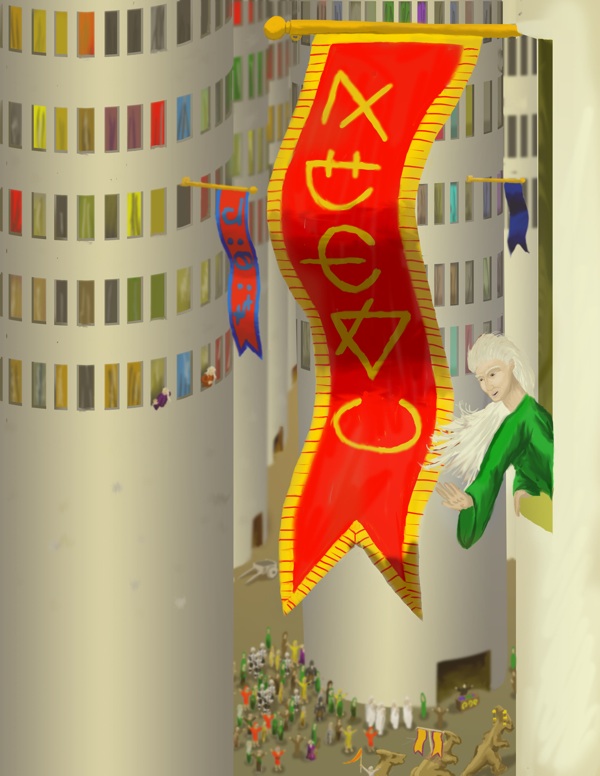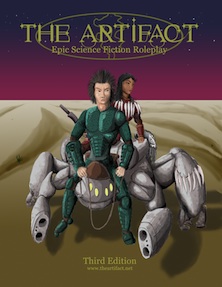When an Espionage Specialist sneaks into a Chezbah settlement, it is useful to understand their customs so as not to give away being an outsider.
City Lifecycle
There are several stages that a Chezbah settlement can be at in it’s life cycle. Understanding the stage of the cycle is important because the stages alter the social fabric of the community. The first stage of a city is reconstruction. During this phase young men and women from other cities are brought to an old city that is in need of repair. As families are established and grow, they work on restoring the city structure. Monitoring priests award titles to family heads according to what they have accomplished. This is a time of political and social jockeying for position. Finding a family low in the rankings and getting their favor by helping them advance can open up repeated access to the community. This is often done by spying on other families and finding out their practices or revealing a scandal that would lower a family’s ranking. Finding families that are in such a position is not difficult because honors are displayed on banners hung from buildings.
The second stage of the city starts when reconstruction ends. The youth in the city are continually sent out to start new cities. The population ages and slowly shrinks over several centuries. In these established cities it may be difficult to find contacts. The city now produces products for other developing cities. This often means there is plenty of work to do and although social ranking can change at this point, it is far more difficult to do so. There is very little a Scimrahn can offer a Chezbah as far as wealth goes but some Scimrahn do find selling black market items to work on occasion. The problem is that revealing a Scimrahn spy carries a very large reward.
The third stage is when some of the city’s children are allowed to return and care for their aging parents. At this point the population of the city is very small and often only takes up a tiny fraction of the buildings in the city. These communities are relatively wealthy and stable but there are often rifts in the social fabric left over from old wounds. In these situations, a Scimrahn may find a place to operate out of by carrying out acts of revenge. These can often be seemingly minor acts of vandalism or harassment because of the Chezbah’s strict social code.
The fourth stage is a slow build up of a city. For a few generations the city’s children are allowed to remain, instead of being sent out to a new restoration site. The city grows slowly over the generations and becomes very rigid socially. Because of the age of most Scimrhan, this stage often offers the opportunity to move about in the city and blend in with youth moving about. However, unlike previous stages, there is little opportunity to attach oneself to a household and have a safe base of operation.
City Buildings
Buildings are often occupied by extended families. It is uncommon for different families to inhabit the same building. One family head is often in control of the entire building.
The residential towers themselves are white except for on the lowest level and around window openings where they are painted with bright blue and yellow patterns. Most patterns are blocks of varying simple geometric patterns that are hand painted on by women of the family.
Higher up there are large colorful banners that hang from the windows. The banners have a family name along with their occupation and then a list of short phrases like “Loc’s servant”, “Strong man”, “Hearer”, “Loyal”, “Good”, “Founder”, “Man of Loc”, “Great” and “Rememberer”.
These banners carry the titles that are awarded to the families for various deeds. Families usually only have a few of these titles and more titles mean more prestige to the family. Each one gives the family certain rights or privileges in society.
Inside the first floor of most of the buildings Pettok or Berem are kept. The entrances are roped off with electrified cable to keep them in. A younger man of the family is stationed here to receive guests and messages. Entering a home without being recognized and escorted means that a person has sinister intentions.
Business is often carried out on the second and third floor of the building and the fourth and fifth floors often have refrigerators pantries and freezers for storing food.
Gesturing Acceptance
Authority and recognizing authority is a life and death matter among the Chezbah. Once a person has been put in charge of something by being given a title by the priesthood, ignoring that authority is a capital offense. The offended has the right to kill a person that rejects their assigned role in society.
One of the main ways of showing that a person’s authority is recognized is by a common gesture. The gesturer’s eyes close and their fingertips touch their forehead. Then the hands are raised into the air.
This is an important gesture to learn because it is the proper response to a range of statements.
The Knife
To the Chezbah, a knife is a symbol of self reliance. It is not often considered a weapon but rather a tool.
At a dinner, a knife is only used to take a portion of the meat that is put in the middle of the table. This is a symbolic gesture showing that the guests are not becoming part of the host’s family but are still able to take care of themselves. Otherwise the patriarchal head of the family serves the meat.
The knife is tied to marriage ceremonies but also in the betrothing process. If someone were to show their knife to a member of the opposite gender it is a proposal to marry. The Tradition goes that a man is showing that he can take care of a woman or the woman asking the man to take her knife which is done during the marriage ceremony.
The Fathers and Mothers
As in the Scimrhan language, “Father” is an honorary title but the term has other uses as well.
The dining table is referred to as “the father”. The table supports the meal and therefore the family, this is the father’s role in Chezbah society. As an extension, plates for eating are also called “fathers”. The cooking pot is called “the Mother” Bowls for eating are called “mothers”. Only the father who’s table it is and his wives may place their bowl directly on the table. Anyone else places their bowls under the table or holds it up while eating. Cups are specialized bowls according to Chezbah tradition.
Dinner Conversation
At the meal, the patriarchal head is the only one allowed to start a conversation. No one may speak unless invited to by the patriarch. There are ways for someone to signal that they would like to speak. Looking directly at the patriarch is one way of doing this. Putting one’s elbow on the table is a demand to be heard.



 The Free RPG Blog
The Free RPG Blog